Multiple Choice
Identify the choice that best completes the
statement or answers the question.
|
|
|
1.
|
Mitosis is the stage of the cell cycle during which
a. | the cell’s nucleus goes through 4 stages and divides into two new
nuclei. | b. | the cell’s DNA is replicated. | c. | the cell’s cytoplasm
divides. |
|
|
|
2.
|
What happens during cytokinesis in animal cells?
a. | Each organelle divides into two parts. | b. | A new round of mitosis
begins. | c. | Two new daughter cells are formed. |
|
|
|
3.
|
What are chromatids?
a. | The 2 halves of a split chromosome. | b. | identical daughter cells | c. | condensed
chromatin |
|
|
|
4.
|
What is the chromosome theory of inheritance?
a. | Hybrid pairs of chromosomes combine to form offspring. | b. | Genes that control
traits are carried from parents to offspring on chromosomes. | c. | Genes that control
traits are carried from offspring to parent on chromosomes. |
|
|
|
5.
|
Walter Sutton discovered that the sex cells of grasshoppers have
a. | the same number of chromosomes found in the body cells. | b. | 12 times the number
of chromosomes found in the body cells. | c. | half the number of chromosomes found in the
body cells. |
|
|
|
6.
|
What happens during meiosis?
a. | Two sex cells combine. | b. | Each sex cell copies itself to form 6 new
chromosomes. | c. | Chromosome pairs separate and are distributed into 4 new sex
cells. |
|
|
|
7.
|
Chromosomes have
a. | many proteins joined together. | b. | transfer RNA. | c. | genes and are made
of DNA |
|
|
|
8.
|
When sex cells combine to produce offspring, each sex cell will
contribute
a. | half(50%) the number of chromosomes in body cells. | b. | twice (200%)the
number of chromosomes in body cells. | c. | one fourth(25%) the number of chromosomes in
body cells. |
|
|
|
9.
|
What are the 4 stages of meiosis?
a. | prophase, metaphase, anaphase, telophase | c. | Interphase, mitosis, cytokenesis,
interphase | b. | beginning, meiosisI, meiosisII, end of meiosis |
|
|
|
10.
|
The difference between mitosis and meiosis is
a. | Meiosis produces 4 cells with 50% chromosomes and mitosis produces 2 cells with 100%
of the chromosomes. | c. | Both a and b explain differences between mitosis and meiosis. | b. | Mitosis produces
body cells and meiosis produces sex cells. |
|
|
|
11.
|
What is a diploid cell?
a. | a diploid cell is a cell with 2 sets of chromosomes. | c. | A diploid cell has only 1/2 the
chromosomes | b. | a diploid cell is a cell with only one set of
chromosomes |
|
|
|
12.
|
After meiosis I is complete you end up with
a. | 2 cells with 100% of the chromosomes. | c. | one identical daughter
cell | b. | 4 cells with 50% of the chromosomes |
|
|
|
13.
|
After meiosis II
a. | the nuclei of the cells have 50% of the chromosomes. | c. | the nuclei have no
chromosomes | b. | the nuclei of the cells have 100% of the chromosomes |
|
|
|
14.
|
At the end of meiosis you end up with
a. | 2 identical daughter cells | c. | 2 non identical sex
cells | b. | 4 non identical sex cells |
|
|
|
15.
|
When extracting DNA from cells the detergent is used for
a. | cleaning the cells | c. | cutting the lipids off the cell and nuclear membranes, freeing the
DNA | b. | precipitating the DNA |
|
Matching
|
|
|
Use the diagram below for questions 35 - 40. Match the letter with the
question. a. | prophase | d. | telophase | b. | metaphase | e. | chromosome | c. | anaphase | f. | chromatids |
|
|
|
16.
|
Which phase is cell #1 in?
|
|
|
17.
|
Which phase is cell #2 in?
|
|
|
18.
|
Which phase is cell #4in?
|
|
|
19.
|
Which phase is cell #5 in?
|
|
|
20.
|
What is the structure labled A
|